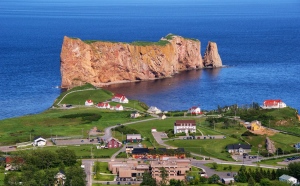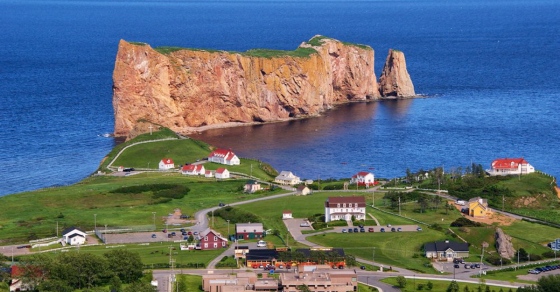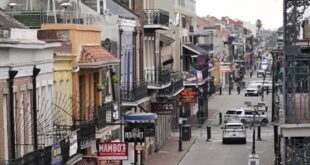
PERCÉ, Quebec
This was going to be a story about lighthouses … until I met a peony named Elsie. And the world’s ugliest fish. And winkles in garlic-butter sauce. And a dented Second World War German torpedo. And galleries. And whales. And waterfalls. And a moose. And 50,000 northern gannets on an island. And cod tongues in sea-urchin butter. And a very big box of live lobsters in yet another picture-book village …
We’ll talk a little about lighthouses, too. But.
Some obligatory orientation: The Gaspé Peninsula is an extension of Quebec roughly the size of Belgium that’s bordered on the north by the St. Lawrence River and extends into the Gulf of St. Lawrence.
It’s got coastline, mountains, renowned salmon fishing and trees that turn brilliant colours in October. Being maritime, it gets its share of rain and fog, which (along with shipping via the St. Lawrence) explains its 14 lighthouses.
Its population is about 130,000, compared — in the same amount of acreage — with Belgium’s population of 11 million. French is widely spoken, but anglophone tourists are welcome and won’t starve.
Largest town is Gaspé (population 15,000). It gave the region its marketable name: Gaspesie. Explorer Jacques Cartier planted a wooden cross somewhere near Gaspé in 1534 and claimed the territory for France, which didn’t quite work out.
The western gateway, for most visitors, is the river town of Sainte-Flavie, and therein begins the problem: You have to really want to get here to get here. The town is a 10 1/2-hour drive from Toronto and nine hours from Boston. Air Canada flies in and out, but a flight from, say, Chicago could get you to Paris cheaper or faster or both, depending on the number of stops.
That’s the end of the problems. The rest is all discovery and joy.
Driving clockwise along the river from Sainte-Flavie on Highway 132 (the road that hugs the water and most everything else worthwhile here), and past Marcel Gagnon’s 80 bizarre statues (the first hint that artists live and thrive here), signs invite us into the sprawling Jardins de Métis, a.k.a. Reford Gardens. Elsie Reford, a lady of means (the means derived from her uncle being a founder of the Canadian Pacific Railway), began planting stuff on the family retreat 90 years ago.
Her great-grandson, director Alexander Reford, 53, has been in charge of every blooming thing (including its treasured blue poppies) for the last 23 years. The garden is a National Historic Site.
“This,” said Reford, “is a beautiful peony here.” The peony is the Elsie, named by the American Peony Society for his great-grandmother. It’s a hybrid — possibly an accident, but as with humans, unintended pollination sometimes works out splendidly.
One of the gardens’ hosts is Paul Gendron, 70. His grandfather was lighthouse keeper at Métis Lighthouse just down the river. “And my father was assistant keeper,” he said. “I grew up there.”
Every lighthouse has its own story, its own personality. We’ll let you discover them.
Three lighthouses east is the charming village of Sainte-Anne-des-Monts, not only the home of the aforementioned winkles (local sea snails, enjoyed at Restaurant du Quai and better than they sound) but of Exploramer, which we’ll describe inadequately as a hands-on aquarium and seaside experience.
A touch pool delights visitors who like touching wet things. Not in the touch pool are great white sharks, one of several species of shark known to lurk in the neighbourhood.
Just past the third lighthouse and the first waterfall — in English, Wedding Veil Falls — is La Martre Lighthouse. Yves Foucreault, who worked here for more than 30 years, continues to show the place off a few years after new management “threw me out.”
“Do you know about the big fight between the lighthouse keeper and the priest?” he began. It’s a good story, especially if it’s really true but even if it isn’t.
We mention the lighthouse at Cap-des-Rosiers because it’s Canada’s tallest (34 metres) and because it’s just before the entrance to Forillon National Park, one of three parks in Gaspesie.
The park is the base for Bay of Gaspé whale-watching cruises. “Sometimes it takes half an hour to gain a good view,” said onboard naturalist Marc Trudel.
On this day, it took 14 minutes to view our first humpback. Fin and minke whales followed. In Forillon, I found my moose, a bear, a porcupine and one more lighthouse, the Cap-Gaspé, a beauty.
Gaspé town is a pleasant-enough stop. Here is the Gaspé Museum, and it contains that dented torpedo, apparently fired by a German U-boat prowling offshore in 1942. “It went off course and kind of ran into the rocks,” guide Nathalie Spooner said of the torpedo. A man found it on the shoreline and kept it in his barn, charging neighbourhood kids 25 cents to see it.
“He called it ‘the world’s smallest museum.’ ” Now it’s in the bigger museum.
Percé, about 400 kilometres from the start of our drive, is a tourist town, a concentration of motels, souvenir shops and restaurants, one of which, La Maison du Pecheur, provided the cod tongues (again, better than they sound).
And speaking of sound: If you’ve never heard the sound of tens of thousands of northern gannets, plus penguinlike murres and razorbills simultaneously making bird noises, you probably haven’t been around Bonaventure Island-Percé Rock National Park. The island is accessible by Percé-based tour boats. Iconic Perce Rock teases photographers with different patterns and colours as the sun makes its rounds … and our exploration ended here, five lighthouses short of full circumnavigation. (We flew home out of the Gaspé airport.)
Except for one more quick stop, at L’Anse-a-Beaufils, a fishing village just past Percé. Here, a genial lobsterman — at a visitor’s request — opened a large cooler filled with living, freshly gathered lobsters.
“I wish I could show you a blue one,” he said, holding up one of them.
Yes, there are blue lobsters. Every lobsterman, like every Gaspésie gardener and guide and naturalist and chef and artist — and lighthouse — has a story.
Alan Solomon is a freelance writer.
[ad_2]You can read more of the news on source
 Travelsmart
Travelsmart



